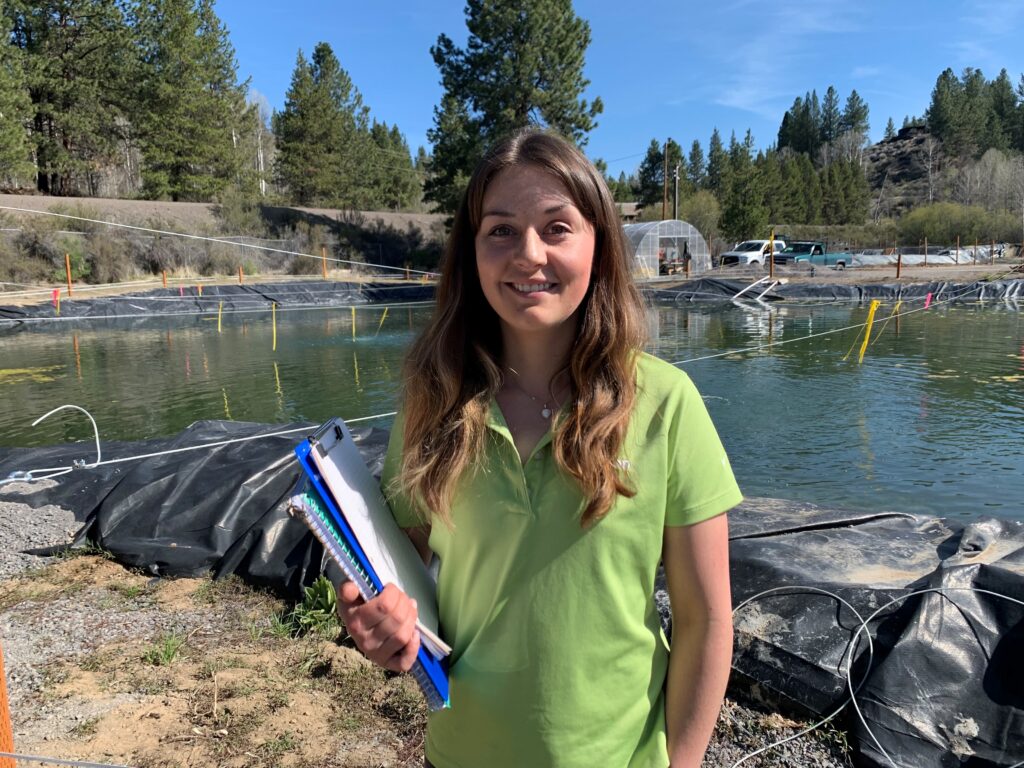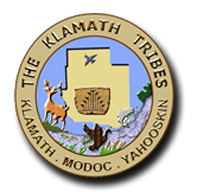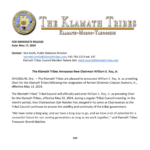FOR IMMEDIATE RELEASE
Date: June 6, 2023
Contact: Ken Smith, Public Relations Director
kenneth.smith@klamathtribes.com;
541-783-2219 ext. 147
Download .pdf New Amobdat Aquaculturist – Klamath Tribes Press Release 6-6-23
New Aquaculturist brings knowledge and passion to the Klamath Tribes’ c’waam and koptu fish rearing facility
CHILOQUIN, Ore. – The Klamath Tribes Ambodat c’waam and koptu fish rearing facility in Chiloquin has a new staff member. Carlie Sharpe, an aquaculturist, has been on the job for a couple of months, arriving from Hagerman, Idaho, where she was working at a fish hatchery raising redband trout. Sharpes received a master’s degree from the University of Idaho in 2022, and conducted her master’s research at the Hagerman Fish Culture Experiment Station studying redband with a focus on water temperature and its impact on the fish. She was also hired as a contractor for Biomark researching fish physiology.
Her work at the Idaho hatchery was an invaluable experience, she said, allowing her to acquire knowledge on the intricacies of raising hatchery fish and the effects of a warming climate on them.
At Ambodat, the endangered c’waam and koptu suckers are being raised in man-made ponds, which are subject to daily temperature fluctuations, characteristic of a high desert climate. With the suckers spending about three years in the ponds before being released, managing the water temperature and elements in the ponds is a complicated process, and critical to the overall health of the fish. And that is why Sharpes position is so important to the work being conducted at Ambodat.
“The decision to hire Carlie reflects advancement of the tribes’ goal to protect and enhance culturally important resources,” said Alex Gonyaw, Ambodat’s senior fish biologist. “She has proven to be a capable and skilled aquaculturist and a wonderful addition to a positive and productive team.”
Sharpes work at Ambodat is challenging but necessary in order for the facility to develop and expand its operation. The long-term goal is to eventually raise Chinook salmon, but the focus now is producing suckers that can survive when released into Upper Klamath Lake.
“Right here, we’re raising fish,” Sharpes said as she stood by one of the four rearing ponds next to the Sprague River. “And we’re doing it in an aquatic environment. In these ponds, we don’t just have fish, we have countless phytoplankton, zooplankton, algae, and invertebrates. It’s an entire ecosystem that can often be overlooked. The culture part of aquaculture is the culture of the water, something you can only see under a microscope.
She added that they are planning to build more aquaculture systems at the facility.
“As we know, in this basin, water is a limiting resource for many stakeholders, including our fish. So that’s the other thing that we’re trying to do – build more systems while remaining mindful about our environmental circumstances.”
Ambodat is both a conservation and supplementation fish facility, with several operations that includes egg collection, egg fertilization, egg incubation, larvae collection, and fish rearing. The primary mission of the hatchery is to keep the fish as wild as they can, quite the opposite of most production hatcheries. The Ambodat fisheries department produces fish that are intended to integrate with a self-sustaining wild population.
“Our main goal is to raise these fish in conditions as close to what they would encounter in the wild as possible,” Sharpes said. “But right now, the wild does not allow for juvenile fish to be recruited into spawning aggregations.”
One of the problems, she said, is that the current state of the local freshwater ecosystem is out of balance and does not allow the juvenile suckers, the larvae, to reach a mature life stage in the wild.
“What we’re trying to do is raise those life stages here, safe, without competition, free from predation,” she said, “and then release them once they get to a life stage where they can naturally survive, and hopefully reproduce in the wild until the water quality improves.”
One of the greatest challenges of Sharpes’ job is maintaining the ponds and keeping them in the most natural condition as possible, which involves managing zooplankton, phytoplankton, chemistry and nitrogenous waste.
“We must mimic a balanced freshwater ecosystem in our man-made ponds as close to the environment for which our suckers have evolved in as possible,” she explained. “So, the ponds would be relatively less stressful than, say, tanks. And we’re trying to keep them in holding tanks, rearing jars for as little amount of time as possible. Same with the ponds. As soon as they’re big enough to where we think that they can survive in the wild, we’re trying to get them right back out there.”
Sharpes said her road to the Klamath Tribes and Ambodat was motivated by her admiration of indigenous peoples’ ecological knowledge, connection to nature, and dedication to environmental preservation.
“It seems to me that tribes are on the forefront of the conservation movement, not only just to bring back endangered species, but to bring back first foods and to restore connection with their deep-rooted 14,000-year-old culture,” she said. “It’s something that’s really not monolithic, either.
“You know, there are hundreds and hundreds of tribes in North America, and they all have different stories, different ways of life. I find that really important to celebrate and support, and I believe that native people deserve justice. Conservation of the environment, or endangered species, for example, is not only important for restoring the ecosystem, or intrinsic value alone, but has a far deeper meaning to native tribes, which is truly beautiful. I am very proud to be a small part of this crucial work with my new role as an aquaculturist for the Ambodat department.”
Aquaculturist Carlie Sharpes is the newest member of the Klamath Tribes Ambodat c’waam and koptu fish rearing program in Chiloquin. (Photo by Ken Smith/Klamath Tribes. Image available for media use.)
About The Klamath Tribes
The Klamath Tribes primary mission is to “protect, preserve and enhance the spiritual, cultural and physical values and resources of the Klamath, Modoc and Yahooskin Peoples by maintaining the customs of our ancestors.” The heart of Tribal life is centered in the area of Chiloquin, Oregon and includes 12 Departments, Health Clinic, Childcare Center, Tribal Court, goos oLgi gowa Center, Research Station, and three tribal enterprises. The Klamath Tribes’ 12 departments facilitate service delivery to multiple aspects of tribal life, including health and fitness, education, economic development, social services, cultural preservation, natural resource protection and more. For more information visit https://klamathtribes.org/.





